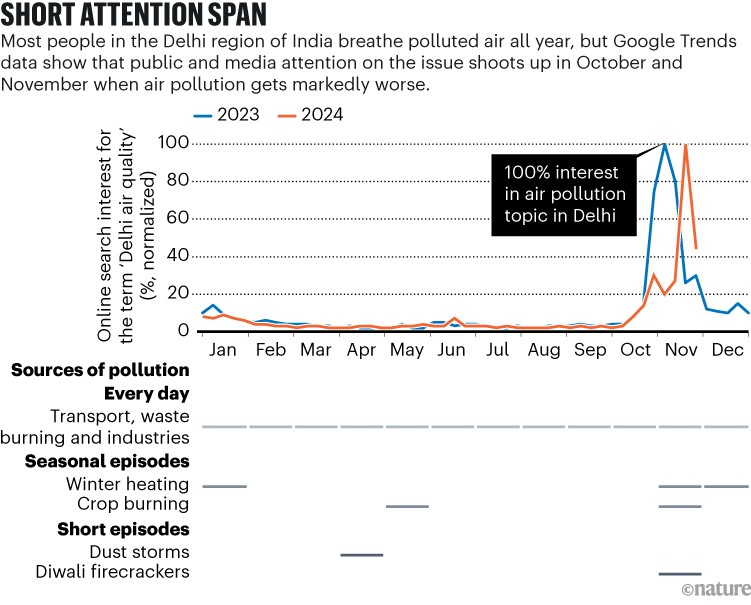Hello Nature readers, would you like to get this Briefing in your inbox free every day? Sign up here.

The CRISPR gene-editing system makes a change to a DNA sequence (middle; artist’s illustration).Credit: Vivid Biology/Science Photo Library
Earlier this month, haemotologists presented results showing that benefits of Casgevy, a breakthrough treatment that uses CRISPR-Cas9 gene editing to treat people with sickle-cell disease and β-thalassaemia, can last for at least five years — offering “the potential to provide a one-time functional cure”. Last year, Casgevy became the first CRISPR-based treatment to be approved by regulators, leaving other developers rushing to emulate its success for other blood disorders and cancer. However, the drug’s complexity and hefty price tag have raised concerns that it will be out of reach for most people.
US president-elect Donald Trump has invited billionaire Elon Musk to help downsize the US government — including potentially slashing the budgets and workforces of science agencies. The SpaceX and Tesla entrepreneur will co-lead a new advisory body, which has been given the tortuous acronym DOGE to echo Musk’s favoured cryptocurrency. The body aims to scale back government spending and regulations, which Musk has complained are choking scientific innovation at his companies and others, a move that experts warn could backfire for research. “If we … just slash the federal enterprise, at the end of the day, we’re going to get less innovation, not more,” says economist Robert Atkinson.
Scientists are warning of the dangers of synthetic organisms in which the ‘handedness’ of life is reversed from its normal flow (in which DNA and RNA are made from ‘right-handed’ nucleotides, and proteins are made from ‘left-handed’ amino acids). A group of 38 researchers warn that such mirror-universe bacteria might be able to evade immune systems and predators such as phages, running riot in ecosystems and causing deadly infections. Others are not so concerned. “I’d argue a mirror-image bacteria would be at a gross competitive disadvantage and isn’t going to survive well,” says molecular biologist Andrew Ellington
Scientific American | 6 min read
Reference: Science policy forum
Features & opinion
Probability probably doesn’t exist — but it is useful to act like it does, argues statistician David Spiegelhalter. From coin flips to weather forecasts, all predictions hinge on subjective, if reasonable, assumptions and judgements. So, outside of quantum mechanics — which offers fixed probabilities founded on firm mathematical ground — what is an objective, or ‘true’, probability? After walking us through the history of attempts to put numbers on chance and uncertainty, Spiegelhalter advises a pragmatic approach to this elusive question.
The thick smog that blankets the region stretching from eastern Pakistan to Bangladesh each November is one the world’s biggest public-health challenges, and there is a solution, argues air-quality researcher Sarath Guttikunda. “The problem stems from multiple, year-round sources — vehicular emissions, waste burning and more,” he writes. Major pollution sources must be addressed through measures such as improving public transport networks and establishing a central air-quality authority to oversee industrial practices to drive emissions down. “It’s time to get serious and treat air pollution as a national emergency.”

Source: Google Trends
We need to acknowledge and preserve the growing archaeological record we’re creating on Mars, argues a group including archaeologists, anthropologists and an astrobiologist. Landing and crash sites on the red planet contain artefacts such as probes, rovers and debris, some of which represent the first humanmade objects to reach another world. “The objects need to be evaluated as important cultural heritage in need of protection because they record the legacy of space exploration by our species,” the group writes. “Any future accidental destruction of this record would be permanent.”
In the first episode of Nature’s new podcast series What’s in a name, researchers explore how species are named, and whether the current system needs to evolve in the face of calls to change problematic examples — such as Anophthalmus hitleri, a beetle named after Adolf Hitler. “No matter where you go you run into some kind of racist history,” says Earyn McGee, a herpetologist whose love of the field was sparked by the Yarrow’s spiny lizard; named after US civil-war surgeon Henry Yarrow, who stole Indigenous remains to sell to museums. “That can definitely be really frustrating when you’re going into nature and you feel like this is like the one place where those things shouldn’t touch, but they do.”
Nature Podcast | 52 min listen
Subscribe to the Nature Podcast on Apple Podcasts, Spotify or YouTube Music, or use the RSS feed.
Today I’m celebrating the engineering nous that is helping a rescued sea turtle with ‘bubble butt syndrome’ thrive in captivity. The endangered Chelonia mydas suffers from an all-too-common spine injury that partially paralyzed its rear flippers and causes it to swim with its bottom up instead of flat. A 3D-printed weighted harness, which helps keep the turtle flat and healthy, is based on research started by engineer Gabriela Queiroz Miranda when she was still in secondary school.
Help keep this newsletter on the straight and narrow by sending us your feedback. Your e-mails are always welcome at briefing@nature.com.
Thanks for reading,
Flora Graham, senior editor, Nature Briefing
With contributions by Jacob Smith
Want more? Sign up to our other free Nature Briefing newsletters:
• Nature Briefing: Careers — insights, advice and award-winning journalism to help you optimize your working life
• Nature Briefing: Microbiology — the most abundant living entities on our planet — microorganisms — and the role they play in health, the environment and food systems
• Nature Briefing: Anthropocene — climate change, biodiversity, sustainability and geoengineering
• Nature Briefing: AI & Robotics — 100% written by humans, of course
• Nature Briefing: Cancer — a weekly newsletter written with cancer researchers in mind
• Nature Briefing: Translational Research — covers biotechnology, drug discovery and pharma
